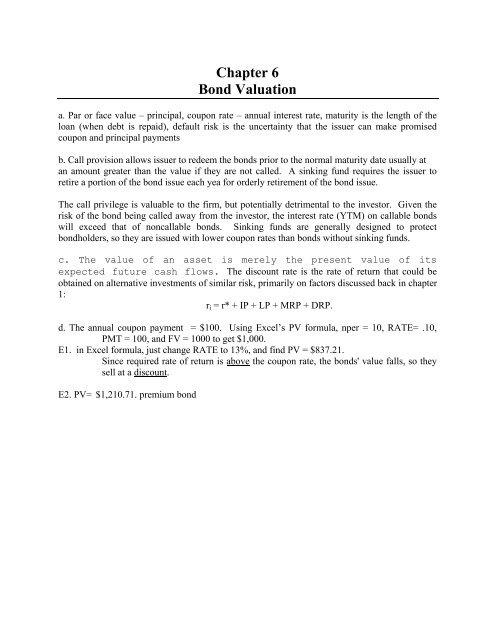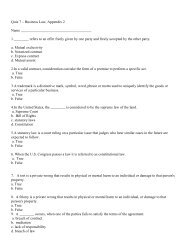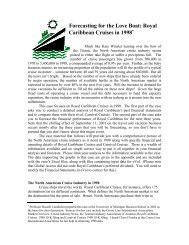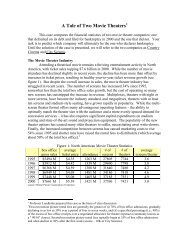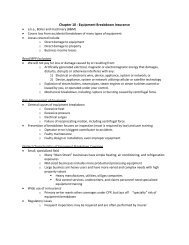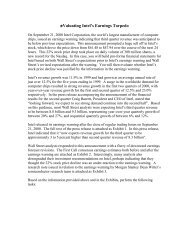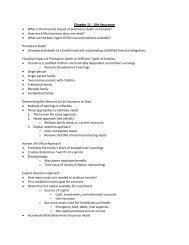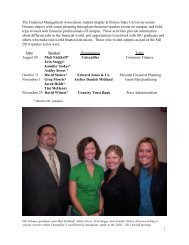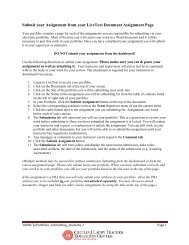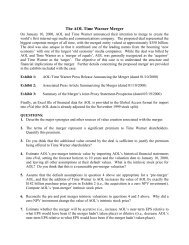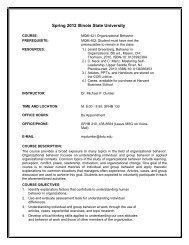You also want an ePaper? Increase the reach of your titles
YUMPU automatically turns print PDFs into web optimized ePapers that Google loves.
<strong>Chapter</strong> 6<strong>Bond</strong> <strong>Valuation</strong>a. Par or face value – principal, coupon rate – annual interest rate, maturity is the length of theloan (when debt is repaid), default risk is the uncertainty that the issuer can make promisedcoupon and principal paymentsb. Call provision allows issuer to redeem the bonds prior to the normal maturity date usually atan amount greater than the value if they are not called. A sinking fund requires the issuer toretire a portion of the bond issue each yea for orderly retirement of the bond issue.The call privilege is valuable to the firm, but potentially detrimental to the investor. Given therisk of the bond being called away from the investor, the interest rate (YTM) on callable bondswill exceed that of noncallable bonds. Sinking funds are generally designed to protectbondholders, so they are issued with lower coupon rates than bonds without sinking funds.c. The value of an asset is merely the present value of itsexpected future cash flows. The discount rate is the rate of return that could beobtained on alternative investments of similar risk, primarily on factors discussed back in chapter1:r i = r* + IP + LP + MRP + DRP.d. The annual coupon payment = $100. Using Excel’s PV formula, nper = 10, RATE= .10,PMT = 100, and FV = 1000 to get $1,000.E1. in Excel formula, just change RATE to 13%, and find PV = $837.21.Since required rate of return is above the coupon rate, the bonds' value falls, so theysell at a discount.E2. PV= $1,210.71. premium bond
E3. At maturity, the value of bond equals its face value (plus accrued interest). Therefore, abond's value must move toward its par value as the maturity date approaches, so premium bondsdecrease and discount bonds increase to $1,000 (barring default).F1. Using RATE function in Excel nper = 10, PV = -887, pmt = 90, and FV = 1000, so RATE=10.91%. Or use IRR based on a table of the cash flows from the bond.Before the calculations, the YTM must be above the 9% coupon rate since the bond is selling at adiscount and discount bonds always have YTM > coupon rate. If the bond were priced at$1,134.20, then it would be selling at a premium and YTM must be below the 9 percent couponrate. Using RATE or IRR, YTM = 7.08%.F2. in the short term, yield is total expected return, which is the sum of the current yield and theexpected capital gains yield.$90Current yi eld = = 0.1015 = 10.15%.$887What is the expected value of the bond 1 year from now, assuming that interest rates remain atcurrent levels? Using PV in Excel, the 9-year bond value = $893.87.So Capital Gains Yield = 0.77%,g. Interest rate risk, which is often just called price risk, is the risk that a bond will lose value asthe result of an increase in interest rates.Maturityr 1-Year Change 10-Year Change5% $1,048 $1,386 38.6%4.8%10 1,000 1,000 25.1%4.4%15 956 749Thus, the 10-year bond has more interest rate price risk. The longer the maturity, the greater thechange in value for a given change in interest rates, r d .h. Renvestment rate risk is defined as the risk that cash flows (interest plus principal repayments)will have to be reinvested in the future at rates lower than today's rate. Since thecoupon payments are significantly less than the principal amount, the reinvestmentrate risk on a long-term bond is significantly less than on a short-term bond.i. The payment stream consists of an annuity with twice as many payments which are halfas much, over double the number of (smaller) periods. When valuing the bond we haveto adjust the yield to maturity to be semiannual too.PMT= $100/2 = $50 and nper = 2(10) = 20, RATE = .13/2 = .065, FV = 1000, and PV then =$834.72.
j. An EAR of 10.25% on the semiannual bond is clearly better than one of 10.0%, which is whatthe annual payment bond offers. Another way to think of it: you get $100 each year,but with the semiannual bond you get some of your money sooner.Since the bond sells for $1000, the YTM = 10%, or an EAR of 10.25%. The annual paymentbond would be found using YTM=10.25%, because investors would insist on getting the sameEAR on the two bonds, because their risk is the same. PV=984.80 using PMT=100, nper=10,and RATE=.1025.K1. nper = 10 (5 years semiannually); PV = -1135.90; pmt = 50; and FV = 1050 (face +callprice). RATE= 3.765%. However, this is the 6-month rate, so we would find the nominal rateon the bond as follows:r Nom = 2(3.765%) = 7.5301% ≈ 7.5%.k2. The company can save on interest expense by refinancing at the current lower rates (coupon=10% vs. coupon of 8%l. The yield to maturity equals the expected rate of return only if (1) the probability of default iszero and (2) the bond cannot be called. For bonds where there is some default risk, orwhere the bond may be called, there is some probability that the promised paymentsto maturity will not be received, in which case, the promised yield to maturity will bemore than the expected return.m. investment grade
n. see p. 231o. When a business becomes insolvent, it does not have enough cash to meet scheduled interestand principal payments. A decision must then be made whether to dissolve the firm throughliquidation or to permit it to reorganize and thus stay alive.The decision to force a firm to liquidate or to permit it to reorganize depends on whether thevalue of the reorganized firm is likely to be greater than the value of the firm’s assets if theywere sold off piecemeal. If the firm is deemed to be too far gone to be saved, it will beliquidated and the priority of claims would be as follows:1. Secured creditors.2. Trustee’s costs.3. Expenses incurred after bankruptcy was filed.4. Wages due workers, up to a limit of $2,000 per worker.5. Claims for unpaid contributions to employee benefit plans.6. Unsecured claims for customer deposits up to $900 per customer.7. Federal, state, and local taxes.8. Unfunded pension plan liabilities.9. General unsecured creditors.10. Preferred stockholders, up to the par value of their stock.11. Common stockholders, if anything is left.If the firm’s assets are worth more “alive” than “dead,” the company would be reorganized. Itsbondholders, however, would expect to take a “hit.” Thus, they would not expect to receive alltheir promised payments. If the firm is deemed to be too far gone to be saved, it would beliquidated.


